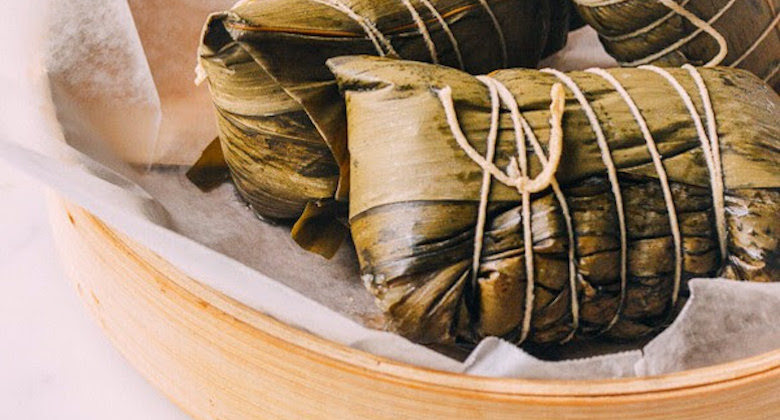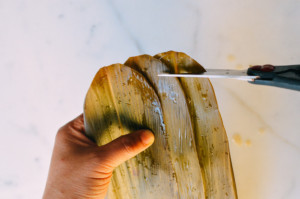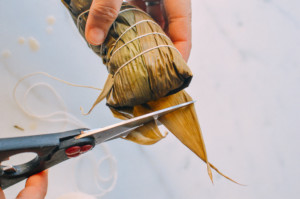https://www.instagram.com/p/6LhuhJSfE6/
The ancient Chinese Dragon Boat Festival, which falls on the fifth day of the fifth month of the lunar calendar (May 30, 2017 this year) is a time for parties, dragon boat races and lots of zongzi (rice dumplings in bamboo leaves).
“It is a tradition for the Chinese to eat zongzi during the Dragon Boat Festival,” says Chloe Zhao of MáLà Project, the cozy East Village spot is known its Sichuan cuisine and especially its dry pot (a sans soup base alternative to the Sichuan hot pot). “[During the festival], people also drink realgar wine, which consists of Chinese cereal wine (yellow wine) dosed with powdered realgar, or a yellow-orange arsenic sulfide mineral.”

Dating back at least 2,000 years, legend has it that the ancient poet Qu Yuan inspired both the dragon boat races and the eating of zongzi. The poet spent years in exile but after learning his home state had been invaded Qu Yuan jumped to his death in the Ni Lo River. Locals raced to the river in their boats attempting to save him, but when they couldn’t find him they dropped balls of sticky rice into the river so the fish would eat them instead of Qu Yaun’s body.

“Nowadays, zongzi is a common food that’s easily found in supermarkets. Some families however still retain the tradition to make zongzi on the festival day,” Zhao said.
Both recipes and the skill of wrapping sticky rice and fillings in the tetrahedral shaped zongzi get passed down through families. Those in northern China tend to make zongzi with sweet fillings like dates, while in the south savory ones like sausages and eggs.
Zhao shared the MáLà Project’s recipe for zongzi below and you watch the annual New York City Dragon Boat Race on Saturday August 12 and Sunday August 13 2017 at Flushing Meadows Park.
Zongzi Recipe (Rice Dumplings in Bamboo Leaves)
Yields: 15 zongzi
Ingredients
36 to 40 dried zongzi leaves* (2 to 3 leaves per zongzi)
5 cups uncooked short grain sticky rice* (also called glutinous rice, or “sweet rice”)
2 tablespoons plus 2 teaspoons light soy sauce*
2 teaspoons plus 1/2 teaspoon salt
2/3 cup of raw peanuts
1 pound pork belly, cut into 12 equal pieces
1/2 teaspoon sugar
2 teaspoons shaoxing wine*
1/2 teaspoon ground white pepper
1 teaspoon oil
1/2 cup water
6 salted duck egg yolks (eggs preserved in a salt brine)*
3 Chinese sausages (you’ll find them in Chinatown supermarkets under the Cantonese name lap cheong, which is generic for a broad range of sausage.)*
*You can find these ingredients in many supermarkets in Chinatown. Try Hong Kong Market (at Hester and Elizabeth Streets) for the biggest selection and some of the ingredients are also available through Amazon or Jet.
Prep
Soak the leaves overnight. The next day, wash and rinse each leaf front and back, keeping them in a large bowl or tub of water until wrapping time so they don’t dry out.
Soak the sticky rice overnight. The next day, drain completely in a colander.
Wrapping the zongzi
Start by layering a couple leaves together and folding up the bottom to create a cone.
Fill with a little rice on the bottom, along with duck egg yolks, Chinese sausages, pork belly and peanuts.
Top with a bit more rice.
Fold the two sides into the middle lengthwise, cupping your hands at the bottom of the cone so it doesn’t fall apart.
Pinch the leaves at the top so you get a tight seal.
Fold the leaves down.
Tight the zongzi securely just get a tightly sealed.
Cut off the excess on the leaves with shears.
Cooking the zongzi
Get a medium-sized pot and neatly nest the zongzi inside, avoiding large gaps. Put a large plate directly on top of the zongzi to weigh them down. Fill the pot with cold water, until the zongzi are submerged. Place the pot on the stove over medium high heat. Once the water boils, turn the heat to low/medium-low, and let it simmer for at least 7-8 hours.
Enjoying your zongzi
Once the 7-8 hours is up, eat the zongzi while they’re hot! Sweet zongzi can be enjoyed at room temperature, but savory zongzi are really the best when they’re steamy and delicious. To eat, simply cut the twine and unwrap the leaves to reveal the zongzi inside. Zongzi can be frozen after they cool to room temperature. To reheat, re-boil the zongzi in water for 15-20 minutes.
Photos courtesy of MáLà Project








